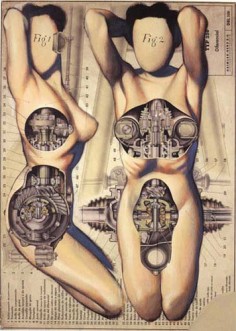FRITZ KAHN
source: fritz-kahn
Dr. Fritz Kahn (1888-1968) was a gynaecologist in Berlin and a world-famous popular science writer who illustrated the form and function of the human body with spectacular, modern man-machine analogies. In the 1920s, his magnum opus, “Das Leben des Menschen” (The Life of Man) – a five-volume series – was renowned as a German accomplishment of global repute. In the 1930s, his books were banned and burned by the Nazis, then edited by Kahn’s publisher and reissued as plagiarisms with a superimposed anti-Semitic chapter.
The Jewish intellectual was expelled from Germany, and settled in Palestine, later in France. He was eventually able to escape his pursuers, with personal help from Albert Einstein, by immigrating to the U.S., where he successfully continued his career as a bestselling author. He spent his final years in Danish exile and died in Ascona, Switzerland in 1968, when he was almost 80, after an extraordinary life and career.
In Germany, Fritz Kahn was silenced. Now some thousand links on the internet demonstrate a newly aroused interest in Kahn, especially among young historians and designers. To this day, creative professionals all over the globe are inspired by the images Kahn’s staff produced for his books almost 100 years ago. Many adapt his inimitable metaphoric approach for their own contemporary interpretations.
The aim of the illustrated monograph “Fritz Kahn – Man Machine” is to popularize his unique works again and to show why and how this valuable part of German cultural history is still alive today.
.
.
.
.
.
.
.
source: fritz-kahn
Dr. Fritz Kahn war ein Berliner Arzt und Wissenschaftsautor, der Bau und Funktionsweise des Menschen mit spektakulär modernen Mensch-Maschine-Analogien veranschaulichte. Sein Hauptwerk, die fünfbändige Reihe „Das Leben des Menschen“ (1922–1931), galt in den zwanziger Jahren als deutsche Leistung von Weltrang. In den dreißiger Jahren wurde es verbrannt und verboten, erschien jedoch im selben Verlag als Plagiat mit antisemitischem Zusatzkapitel.
Fritz Kahn, Jude und Humanist, wurde ausgewiesen und ließ sich in Palästina nieder, später zog er nach Frankreich. Mit Hilfe seines Freundes Albert Einstein entkam er seinen Verfolgern in die USA, wo er seine Karriere als Bestsellerautor erfolgreich fortsetzte. Nach Europa zurückgekehrt, starb Kahn 1968 nach einem außergewöhnlichen Leben und Werk fast 80-jährig in der Schweiz.
In Deutschland geriet Fritz Kahn weitgehend in Vergessenheit, doch inzwischen zeigen tausende Links im Internet ein neu erwachtes Interesse an ihm, vor allem unter jungen Historikern und Gestaltern. Bis heute inspirieren die Bilder, die Kahn in der frühen Moderne für seine Bücher anfertigen ließ, Kreative in aller Welt zu eigenen zeitgemäßen Interpretationen.
Fritz Kahn wieder sichtbar und sein einzigartiges Werk als lebendigen Teil der deutschen Kulturgeschichte begreifbar zu machen, ist das Ziel dieser Website und des monografischen Bildbandes „Fritz Kahn – Man Machine“.
.
.
.
.
.
.
.
source: artecreha
Fritz Kahn (1888-1968) alcanzó notoriedad en la década de los años 20 a raíz de la publicación de un libro titulado “Das Leben des Menschen” (La vida de la gente) en el que representaba el interior del cuerpo humano a modo de grandes maquinarias controladas por pequeños personajes.
No se trataba de una pequeña publicación, sino de una gran obra en la que Fritz Kahn daba rienda suelta a una desbordante imaginación. Por desgracia, la trayectoria vital de este médico alemán se vió condicionada por el acceso de los nazis al poder, puesto que estos rechazaron de plano este tipo de publicaciones.
En los últimos años, se han multiplicado las exposiciones, la reediciones y hasta las recreaciones en vídeo de las ilustraciones de Fritz Kahn. La razón de esta recuperación del trabajo de Kahn hay que buscarla en la fascinación que nos produce la ingenuidad de aquel maquinismo, mezcla de ciencia ficción y evocaciones archimboldianas.
.
.
.
.
.
.
.
source: lemadblog
Le docteur Fritz Kahn (1888-1968) était un gynécologue berlinois mais il fut aussi reconnu pour ses illustrations anatomiques, sa vision du corps humain comme une vivante, comme une machinerie… idée reprise bien plus tard par Kraftwerk.
Dans les années 1920, son opus magnum, « Das Leben des Menschen » (La vie de l’homme) – une série en cinq volumes – connu une renommée mondiale. Dans les années 1930, ses livres ont été interdits et brûlés par les nazis… Cet intellectuel juif fut expulsé d’Allemagne, et s’installa d’abord en Palestine, puis en France. Il réussi finalement à échapper à ses poursuivants, avec l’aide personnelle d’Albert Einstein, après avoir immigré aux États-Unis, où il a poursuivi avec succès sa carrière comme auteur à succès. Il a passé ses dernières années en exil au Danemark et est mort à Ascona, en Suisse en 1968.
En dépit de ses difficultés et ses voyages, Kahn produisit de nombreuses illustrations de sa vision « mécaniste » au charme cyberpunk avant l’heure.


